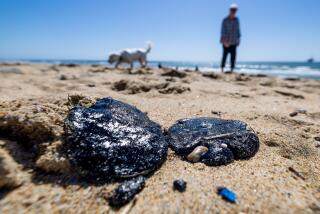Oil spill into Ventura County creek raises concerns for endangered species
- Share via
Crews are scheduled around the clock this weekend to clean up a spill that released more than 200 gallons of crude from an oil field in the Ventura County backcountry.
A leak in a pipe linking storage tanks at a Vintage Petroleum facility north of Fillmore was detected during a regular inspection Tuesday afternoon. The spill flowed into Tar Creek, a tributary of Sespe Creek.
Government officials and biologists insist the spill of only about five barrels -- along with 50 barrels of oil-laced groundwater, or about 2,100 gallons -- poses no immediate threat to endangered species in the area.
But environmentalists worry that such a spill just a few miles from Tar Creek’s junction with Sespe Creek could pose long-term problems for endangered and threatened species, such as the California condor and steelhead trout.
“Any time you introduce hundreds of gallons of oil into a relatively pristine ecosystem, you’re going to have significant impacts,” said Jeff Kuyper, executive director of Los Padres ForestWatch, a nonprofit group that monitors land use in the national forest.
The forest, which includes the famed Big Sur coastline, stretches from Monterey County into northern San Luis Obispo County and Ventura, Santa Barbara and Kern counties.
The spill, blamed on a leak caused by recent cold weather, occurred in a developed oil field northwest of Hopper Mountain, an area that includes federal and private land within the forest’s borders. Although original estimates suggested it could take up to three weeks to clean the three miles of creek despoiled by the spill, a company representative said Friday the job should be completed late next week.
“We regret that this happened. Our employees out there work so hard to avoid this type of thing. We’ll figure out some preventative measures” to avoid a recurrence, said Jan Sieving, spokeswoman for Occidental Petroleum, which acquired Vintage last year.
About 40 people -- Occidental staff and workers from its subcontractor, Rancho Dominguez-based Advanced Cleanup Technology Inc. -- are using berms made of earth, vacuum trucks, absorbent pads, flotation devices and a boom to clean up the crude, described as having the consistency of motor oil. A second, backup boom is installed a mile from the Sespe to try to ensure that oil doesn’t get through to the bigger creek.
The company will probably replace a 30-foot section of the 1-mile-long pipeline, but if an inspection determines that more work is needed, the entire line could be upgraded, Sieving said.
Initial fears about the spill occurring close to the Sespe Condor Sanctuary seem to be unfounded, according to Kathy Good of the U.S. Forest Service.
“There is no immediate threat,” Good said. “Condors do drink water and bathe at a location close to the intersection of Tar and Sespe creeks, but the area they frequent is several miles downstream.”
Mark Hall, manager of the Hopper Mountain National Wildlife Refuge, said only two of 28 condors known to be in the area regularly roost near the spill location.
But David Pritchett of the Southern California Watershed Alliance said people who care about fish habitat are concerned about all spills.
“Oil in the water is bad for fish,” Pritchett said. “Of real concern is that gooey oil will cover up the gravel in the streambeds, which is where the fish spawn. And too much oil in the water is toxic.”
*
More to Read
Sign up for Essential California
The most important California stories and recommendations in your inbox every morning.
You may occasionally receive promotional content from the Los Angeles Times.










